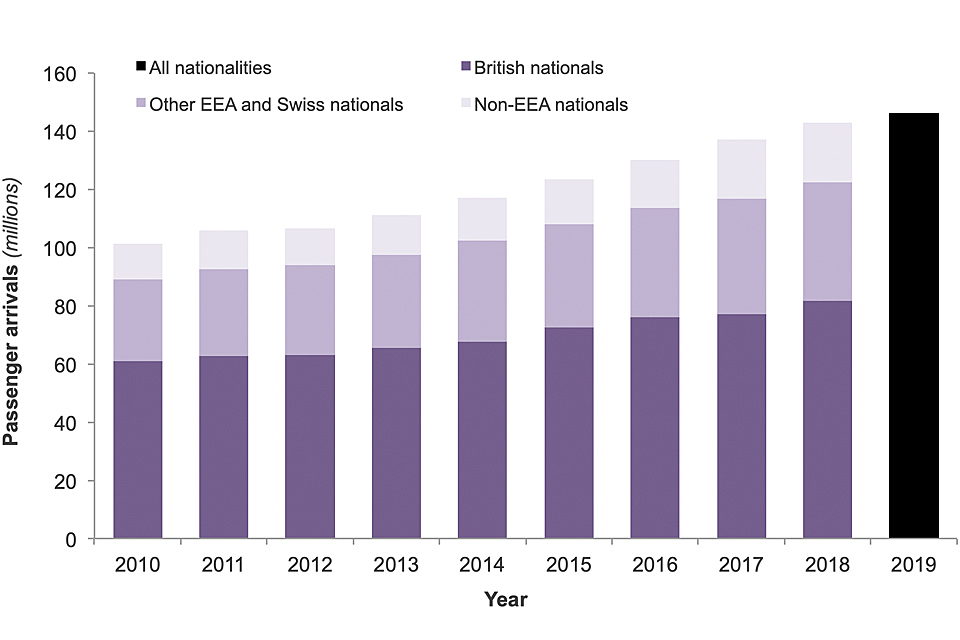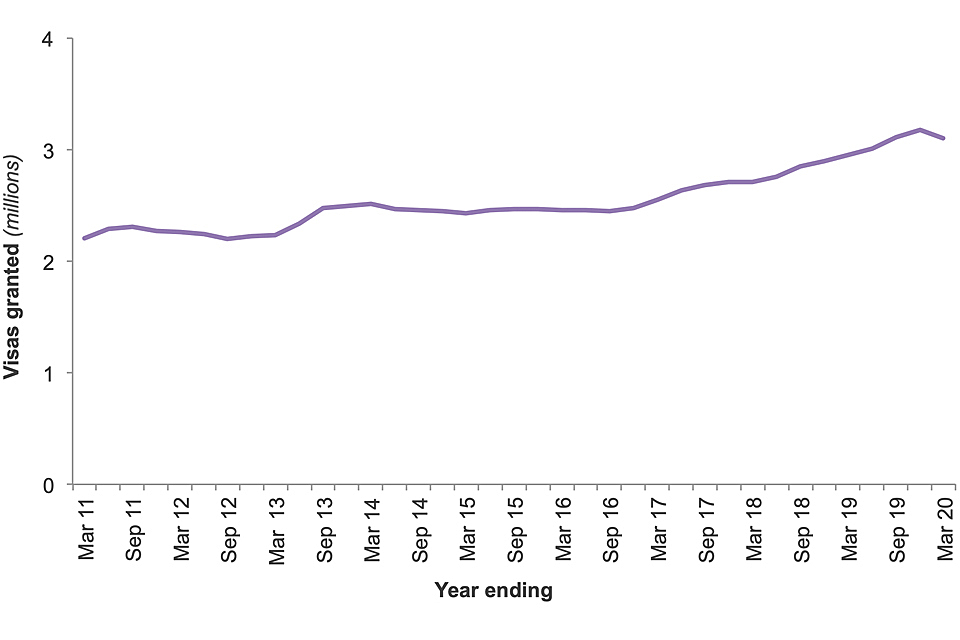How many people come to the UK each year (including visitors)?
Published 21 May 2020
Back to ‘Immigration statistics, year ending March 2020’ content page.
This is not the latest release. View latest release.
Data in this section relate to the year ending March 2020 and all comparisons are with the year ending March 2019, unless indicated otherwise. A more detailed annual summary can be found in ‘Immigration statistics, year ending June 2019 second edition’.
This section contains data on:
- passenger arrivals to the UK
- Grants of Entry clearance visas to individuals outside the UK
- visitors to the UK
1. Passenger arrivals to the UK
There were an estimated 140.9 million passenger arrivals in the year ending March 2020 (including returning UK residents), a 2% (3.4 million) decrease compared with the previous year.
Figure 1: Passenger arrivals to the UK, by nationality group, 2010 to 2019

The chart shows the number of passenger arrivals to the UK, by nationality group over the last 10 years.
Source: Passenger arrivals (admissions) summary table – Adm_01
Notes:
- Nationality breakdowns for 2019 are not currently available, as the data were derived from landing cards (see ‘Landing cards’ below).
In 2018, the latest period for which a breakdown is available, there were 142.9 million passenger arrivals, of which 81.7 million were returning British citizens, 40.8 million other EEA nationals and 20.4 million from outside the EEA. Only certain nationalities (“visa-nationals”) are required to obtain an Entry clearance visa before coming to the UK, which is why there are considerably more passenger arrivals than visas granted.
There were 3.1 million visas granted in the year ending March 2020, a 5% increase compared with the previous year, continuing the upward trend seen over the last decade. Of these, three-quarters (75%) were to visit, 10% were to study (excluding Short-term study), 6% were to work, 2% were for family, and 7% for other reasons.
Figure 2: Entry clearance visas granted, years ending March 2011 to March 2020

The chart shows the number of Entry clearance visas granted over the last 10 years.
Source: Entry clearance visa applications and outcomes – Vis_D02
1.1 The effects of COVID-19 on visitors to the UK
The Home Office is publishing a separate report on 28 May 2020, which will provide a statistical overview of COVID-19 impacts on the immigration system through into April. However, some changes were already visible in the period to the end of March 2020.
In the first quarter of this year (January to March 2020), there were an estimated 23.7 million passenger arrivals (including returning UK residents). This is an 18% (5.4 million) decrease compared with the same period in 2019, with significant falls towards the end of the quarter.
At the same time the number of applications for visitor visas in the first quarter of 2020 was 26% lower (-145,098) than in the same period in 2019.
2. Visitors to the UK
In the year ending March 2020, there were 2.6 million applications for Visitor visas, an increase of less than 1% compared to the previous year. Many nationalities, including US nationals who account for one-third of passenger arrivals, do not normally require a visa to visit the UK; consequently, there are considerably fewer Visitor visas granted than visitor arrivals.
Over the same period, there were 2.3 million Visitor visas granted (including dependants), a 2% increase, following a general upward trend over the last 10 years. Chinese (586,179) and Indian (497,999) nationals together accounted for just under half (46%) of all Visitor visas granted.
In the latest year, there were notable increases in Visitor visas granted to:
- Nigerian nationals, up 23,216 (33%) to 93,263
- Russian nationals, up 18,839 (16%) to 137,121
There was a fall in the number of visitor visas granted to Chinese nationals, down 19,034 (3%), probably due to travels restrictions implemented in response to Covid-19.
Additional information on visitors to the UK are published by the Office for National Statistics (ONS) in its quarterly ‘Overseas travel and tourism statistics’.
3. About these statistics
The statistics in this section provide an indication of the number of people who enter the UK.
The data do not show whether, or when, an individual arrived in the UK, what they did on arrival to the UK or how long they stayed in the UK.
Many non-EEA nationals do not normally require a visa to visit the UK. As a result, they will be counted in the passenger arrivals data but not in the visa data. A list of designated nationalities referred to as ‘visa nationals’ who do require a visa in order to visit the UK can be found in ‘Immigration Rules Appendix V: visitor rules’.
EEA and Swiss nationals do not require a visa to come to the UK for any reason.
For several reasons, data on passenger arrivals are not directly comparable with data on Entry clearance visas granted. A summary of what each dataset counts is provided below.
3.1 Passenger arrivals
Data on passenger arrivals relate to the number of arrivals into the UK. The data include British, EEA and Swiss nationals, as well as non-EEA nationals. For non-EEA nationals who are subject to immigration controls, more detailed information is available on their nationality and purpose of their journey up until 2018.
Passenger arrivals are counted each time an individual enters the UK. Where an individual enters the UK more than once in a period, they will be counted each time they enter (but if they arrive each time on the same visa, they will be counted once in the visas data).
Visitor arrivals data included in this topic are based on landing cards completed as people cross the border. In light of the introduction of new digital systems at the border, the use of landing cards was reviewed (see ‘Landing cards’ below). The review resulted in the decision to remove the need for non-EEA nationals to complete a landing card on arrival into the UK. Further data relating to visitor arrivals will not be available until an alternative method of collection is developed.
3.2 Entry clearance visas
Data on Entry clearance visas in this section refer to the number of visas granted for all reasons within the period. If an individual was granted multiple visas in a given period, this will be counted as multiple grants in the statistics. If an individual entered the UK multiple times within the period for which a visa was valid, this will be counted as one grant in the visa statistics, but multiple arrivals in the passenger arrivals data.
Year-on-year comparisons of the number of decisions can be affected by quarterly fluctuations in the data. Such fluctuations can be examined in more detail in the quarterly data that are available in the published tables.
Several known factors may have affected the number of applications and outcomes of visit-related visas over time. For example, the Home Office launched a two-year Chinese visa pilot in January 2016 for Chinese nationals. The increase in longer-term Visitor visas may affect the number of subsequent re-applications by Chinese nationals.
More information on non-visitor arrival and visa data by category is included in ʻWhy do people come to the UK? To work’, ʻWhy do people come to the UK? To study’ and ʻWhy do people come to the UK? For family reasons’.
3.3 Landing cards
On 5 August 2017, the Home Office launched a consultation on ending the requirement for non-EEA passengers to present a paper landing card on arrival into the UK from 1 October 2017. The consultation set out the statistical implications of the change and the consultation closed on 2 September 2017. The government confirmed in the Spring Statement 2019 that to coincide with the ePassport gates expansion, the government would begin to abolish landing cards for non-EEA travellers. On 20 May 2019, it removed the need for all non-EEA travellers to fill in landing cards upon arrival in the UK and expanded the use of ePassport gates to seven more countries. The government’s response to the consultation was published in May 2019. As anticipated in the original consultation, ahead of new electronic data sources being developed, the withdrawal of landing cards has resulted in a temporary loss to the passenger arrivals data broken down by nationality and reason for travel. The last set of published data on non-EEA nationals arriving in the UK (based on Landing Cards), cover the period 2004 to 2018) are available in ‘Immigration statistics, year ending June 2019 second edition’. Data on the total number of passenger arrivals will continue to be available as this comes from a different source.
4. Data tables
- Sponsorship summary tables
- Detailed sponsorship datasets
- Entry clearance visas summary tables
- Detailed Entry clearance visas datasets
- Admissions tables
We welcome your feedback
If you have any comments or suggestions for the development of this report, please provide feedback by emailing MigrationStatsEnquiries@homeoffice.gov.uk. Please include the words ‘PUBLICATION FEEDBACK’ in the subject of your email.
See section 7 of the ‘About this release’ section for more details.
